Grow an Orange Tree
or Grapefruit, Lemon
& Other Citrus
To grow an orange tree in your backyard is one of the perks of South Florida living. Here are all the basics you need to know about growing citrus trees.
This guide is can be used for all types of citrus and most other fruit-producing trees including avocado, mango, and litchi.
NOTE: Due to citrus greening, less and less nurseries are carrying citrus. You may have to buy from Rare Fruit sales and expos. And you might lose your citrus eventually to this destructive disease...so it may not be something you want to plant until a cure is found.
Planting
Citrus needs a sunny, well-drained spot to thrive.
Planting citrus 12 to 15 feet from the house and other trees is ideal.
Clear away grass from the area.
Dig a hole 1-1/2 times the size of the container.
Add composted cow manure to the hole. Do not add top soil or peat moss - they'll keep the soil too moist. Citrus trees don't like 'wet feet' and need to dry out between waterings.
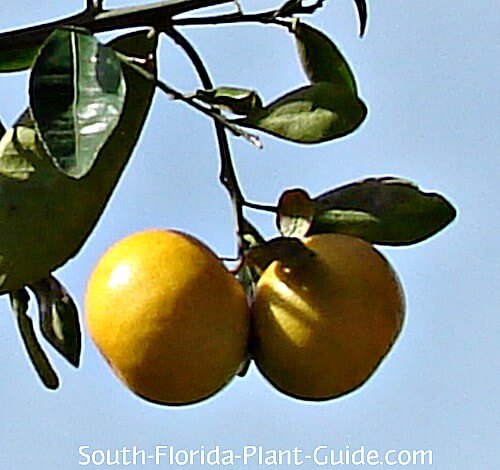
Place the plant a little higher than the soil
surface, fill in around the root ball and pack the dirt firmly. The top
of the plant's soil as it was in the container should still be visible.
Do not mulch. This holds in unwanted moisture.
Using leftover soil from digging the hole, make a "bowl" around the newly planted tree.
Water once a day for the first three to five days by filling the bowl with water and letting it drain. Repeat this three or four times until you're certain the water has reached the bottom of the root ball.
After the initial three to five days, water the tree once or twice a week during winter, and two to three times a week in summer, depending on rainfall.
Keep grass from growing around the base of the tree. See the picture below for the ideal bare space.
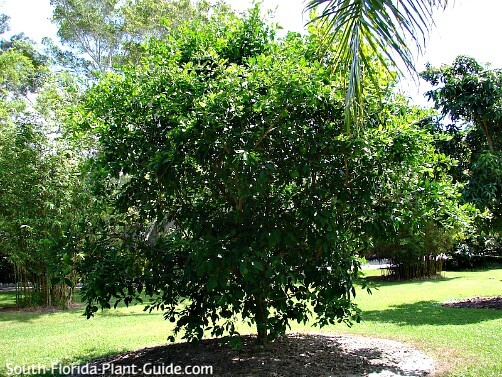
Fertilizing
To grow an orange tree successfully, fertilizing is a necessity.
After the tree has been in the ground a month, apply slow-release citrus fertilizer (4-0-8).
Sprinkle it around the drip-line (farthest foliage point).
For young trees, you can do a small feeding once a month. Use 1/4 lb. per foot of branch spread (the overall diameter of the tree).
Once the tree is established, fertilize three times a year - in spring, summer, and autumn.
For mature trees use 1 lb. per foot of branch spread.
Important: Always water well before and after fertilizing. Give the plant at least an hour to "drink" before applying fertilizer. Do a light watering afterwards to keep the fertilizer in place.
Spraying
This is the part of caring for citrus that most people fail to do - but it helps the tree produce more and better fruit and fights off pests.
Spray with:
Neem Oil (2 TBSP. per gallon of water) in summer. Spring and fall use a mixture of Liquid Copper (2 tsp. per gallon of water) and
50% Malathion (2 tsp. per gallon of water), and add a miticide to combat mites.
Do this in spring, summer and fall.
In spring, spray when the first flowers open to help set the bloom. DO NOT spray if there are a lot of blooms already open as this may interfere with pollination necessary for fruit production.
In late spring or early summer, spray when the fruit is about 1/4 inch in diameter to help to set the small fruit.
In autumn, spray when the fruit is close to ripening.
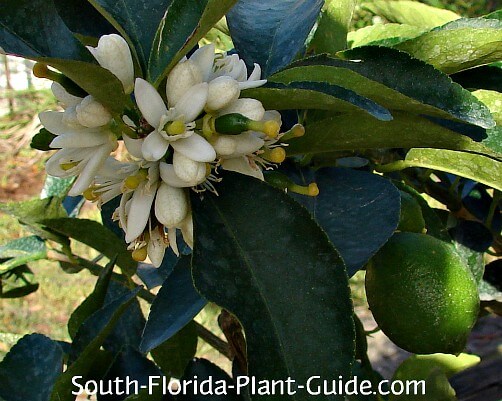
Harvesting
Fruit is ready when it pulls easily from the branch but if it's not completely ripe it will ripen off of the tree as well.
You can't always go by fruit color to know when something is ripe.
Winter temperatures can affect the color of fruit. Some oranges turn orange during a normal winter - but if winter is unusually mild they may remain green on the outside.
Oranges and other citrus generally have a "season" for producing fruit. Lemons and limes, however, are considered "everbearing" and will yield fruit on and off all year.
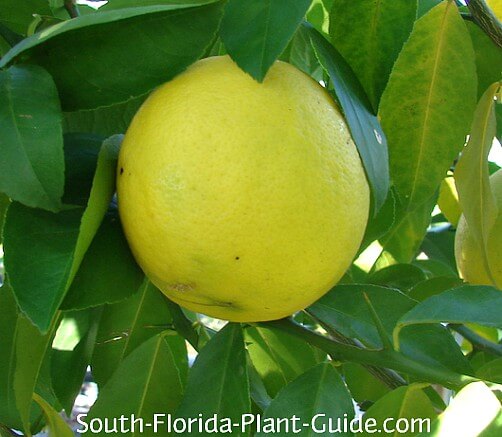
Pruning
When you grow an orange tree you want fruit to be accessible.
Pruning branches as you harvest fruit keeps the tree shaped and gives it enough time to regenerate for the following fruiting season.
Keeping a tree smaller and more compact not only reduces the amount of fertilizer and pesticide you'll need to use, but branches will also be stronger to hold more fruit.
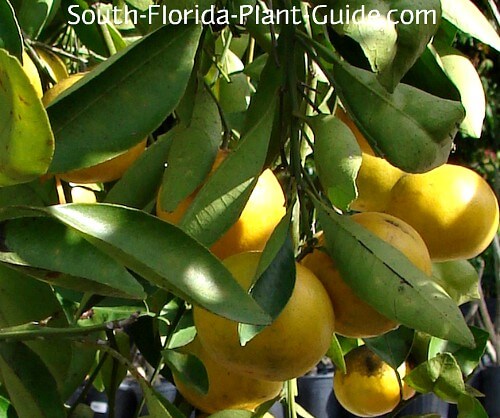
What is grafted citrus?
Most types of citrus trees - other than lemon and lime - are grafted onto a fast-growing rootstock.
This allows a tree to produce fruit when young.
Plant nurseries sell grafted trees. The graft is a knuckle-like area on the lower trunk.
Remove any growth sprouting from below the graft.
Common citrus varieties
ORANGE
Navel - Nov-Feb
Red Navel - Nov-Jan
Hamlin - Oct-Jan
Temple - Jan-Mar
Valencia - Mar-June
Pineapple - Dec-Feb
LEMON
(all everbearing)
Meyer
Eureka
Ponderosa
LIME
(all everbearing)
Persian
Key
Limequat
TANGERINE
Dancy - Dec-Jan
Murcott - Jan-April
Sunburst - Nov-Dec
TANGELO
Minneola "Honeybell" - Dec-May
Orlando - Nov-Jan
GRAPEFRUIT
Ruby Red - Nov-May
White - Nov-May
Pink - Nov-May
KUMQUAT
Meiwa - Nov-May
Nagami - Nov-May
Average heights
Orange 20-25'
Tangerine 20-25'
Tangelo 20-25'
Grapefruit 25'
Lemon 15-20'
Lime 10-15'
Cold tolerance
Lemons and Limes: 30-35 degrees (F)
Grapefruit: 25-30 degrees (F)
Oranges and Tangeloes: 20-25 degrees (F)
Tangerines, Mandarins, Calamondins & Kumquats: 15-20 degrees (F)
NOTE: Key Lime is cold sensitive and should only be planted in Zone 10.
Cold protection
Citrus trees can sustain branch end damage - but it's mainly the fruit that's more at risk.
Citrus can handle the temperatures listed above for 8 to 10 hours before suffering any branch end damage.
Freezing temperatures can make fruit dry and pithy. Cover your tree with a thick quilt or blanket - or use frost cloth, which is lighter and easier to handle.
Water the tree thoroughly early in the day before a cold night to prevent branch end and fruit damage.
If a tree is damaged by cold, don't trim the dead branches until spring (late March to early April). The damaged areas help to absorb the brunt of future cold spells.
Take a break!
The ultimate guide to low-maintenance plants
and landscaping!
An ebook by
Chase Landre
author of
South-Florida-Plant-Guide.com
Learn more!
Get a greener thumb!
Want to learn more about South Florida planting, watering, fertilizing and dealing with weeds and pests?
See our Gardening How-To section for answers!
Get instant curb appeal!
An ebook by
Chase Landre
author of
South-Florida-Plant-Guide.com
Learn how to get instant curb appeal with fast growing plants and landscaping techniques!



